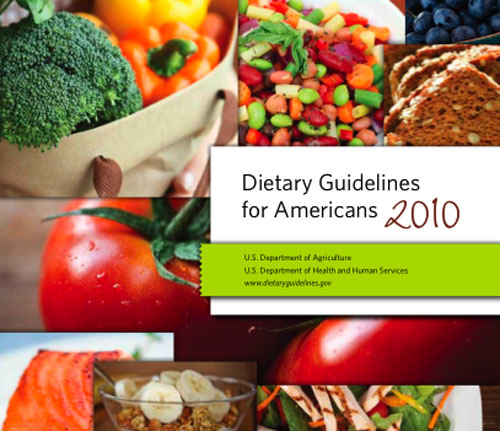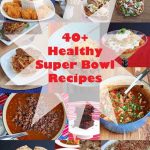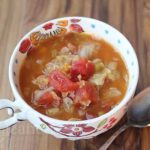This is the fourth post in a series that I’ve been writing, summarizing the 2010 Federal Dietary Guidelines for Americans that was recently released. I’ve posted summaries on “Balancing Calories to Manage Weight” and “Foods and Food Components to Reduce” already and will be summarizing “Foods and Nutrients to Increase” today.
- Eating more vegetables and fruits will help close the gap on nutrients that are currently underconsumed in the U.S., including folate, magnesium, potassium, dietary fiber, vitamins A, C, and K.
- Consumption of vegetables and fruits is associated with a reduced risk of many chronic diseases. Eating 2 ½ cups of vegetables and fruits per day is associated with a reduced risk of cardiovascular disease, including heart attack and stroke (some vegetables and fruits may also be protective against certain types of cancer).
- Most vegetables and fruits, when prepared without added fats and sugars, are relatively low in calories, and can help adults and children achieve and maintain a healthy weight.
HOW?
- Add dark-green, red and orange vegetables to soups, stews, casseroles, and stir-fries. Use dark leafy greens, such as romaine lettuce and spinach, to make salads.
- Add beans to salads (e.g., kidney or garbanzo beans), soups (e.g., split peas or lentils) and side dishes or serve as a main dish.
- Keep raw, cut-up vegetables handy for quick snacks, served with yogurt-based dressings or hummus instead of sour cream or cream cheese-based dips.
- Use fruit to top cereal and pancakes.
- Use fruit as snacks, salads or desserts.
- Use whole fruits (fresh, frozen, dried, and canned fruit in 100% fruit juice over fruit canned in syrup) rather than juice; 100% fruit juice lacks dietary fiber and when consumed in excess can contribute extra calories.
2. Consume at least half of all grains as whole grains by replacing refined grains with
whole grains.
- Whole grains are a source of iron, magnesium, selenium, B vitamins and dietary fiber.
- Moderate evidence indicates that whole grain intake may reduce the risk of cardiovascular disease and is associated with lower body weight.
- Limited evidence also shows that consuming whole grains is associated with a reduced incidence of type 2 diabetes.
- Consume at least half of total grains as whole grains (e.g., brown or wild rice, oatmeal, whole grain barley, whole wheat, whole rye, buckwheat, bulgur, millet, quinoa).
- Substitute whole-grain choices for refined grains in breakfast cereals, breads, crackers, rice and pasta, e.g., 100% whole-grain breads; whole grain cereals such as oatmeal; whole-grain crackers and pasta; and brown rice.
- Use the Nutrition Facts label and the ingredients list to choose whole grains that are good (10-19% of Daily Value per serving) or excellent sources of dietary fiber (20% or more of Daily Value per serving).
- Eat fewer refined grain products, especially those that are high in calories from solid fats and/or added sugars, such as cakes, cookies, other desserts and pizza.
(e.g., yogurt, cheese) or milk alternatives (e.g., fortified soymilk.)
- Milk and Milk Products contribute calcium, vitamin A, vitamin D (for products that are fortified with vitamin A and D), and potassium to the diet.
- Moderate evidence shows that intake of milk and milk products is linked to improved bone health (especially in children and adolescents), and a reduced risk of cardiovascular disease, type 2 diabetes, and lower blood pressure in adults.
- Intake of milk and milk products, including fortified soymilk is less than recommended amounts for most adults, children and adolescents ages 2-18.
- Choose fat-free (skim) or low-fat milk (1%) and milk products (e.g, as yogurt cheese), which provide the same nutrients with less solid fat and fewer calories.
- When drinking beverages, such as cappuccino or latte, request fat-free/ow-fat milk, or soy milk.
- Choose fat-free or low-fat milk or yogurt more often than cheese. Milk and yogurt are better sources of potassium and are lower in sodium than most cheeses.
- Recommended amounts are 3 cups per day of fat-free or low-fat milk and milk products for adults and children and adolescents ages 9-18 years, 2 ½ cups per day for children ages 4-8 years, and 2 cups for children ages 2-3 years.
- As an alternative to milk and milk products, choose soymilk, almond milk, rice milk, or hemp milk that are fortified with calcium and vitamins A and D.
4. Choose a variety of protein foods, focusing on proteins low in saturated fat, including
seafood, lean meat and poultry, eggs, beans and peas, soy products and unsalted nuts
and seeds.
WHY?
- The fats in meat, poultry and eggs are considered solid fats, while the fats in seafood, nuts and seeds are considered oils.
- Protein foods contribute B vitamins, vitamin E, iron, zinc and magnesium to the diet.
- Seafood contributes a range of nutrients, especially omega-3 fatty acids (EPA and DHA). Moderate evidence shows that consumption of about 8 ounces per week of a variety of seafood provides an average consumption of 250 mg per day of EPA and DHA, and is associated with reduced cardiac deaths among individuals with and without pre-existing cardiovascular disease.
- Moderate evidence indicates that intake of omega-3 fatty acids, in particular DHA, from at least 8 ounces of seafood per week for women who are pregnant or breastfeeding is associated with improved infant health outcomes, such as visual and cognitive development (Note: pregnant or breastfeeding women should avoid fish high in methyl mercury, including tilefish, shark, swordfish, king mackerel and limit consumption of white tuna which is higher in methyl mercury than light canned tuna.)
- Reduce the amount of meat and poultry in your diet, which contains solid fats, and replace with protein foods that contain no solid fats (e.g., beans, seafood, nuts and seeds).
- Choose lean forms of meat or poultry to decrease intake of solid fats (e.g., 90% lean meat; drain fat from meat when cooking, and remove poultry skin before cooking or eating).
- Choose seafood (e.g., fish and shellfish) in place of some meat and poultry. Fish contain oils, not solid fats (best choices are fish that are low in mercury such as salmon, anchovies, herring, sardines, Pacific oysters, trout and Atlantic and Pacific mackerel, not king mackerel which is high in mercury). Eat 8 or more ounces per week of a variety of seafood.
- Eat more beans, which are excellent sources of protein, iron, zinc, dietary fiber, potassium and folate.
- Consume a balanced variety of protein foods. Moderate evidence indicates that eating peanuts and certain tree nuts (e.g., walnuts, almonds, and pistachios) reduces risk factors for cardiovascular disease. Because nuts and seeds are high in calories (and salt, unless you choose unsalted nuts), they should be eaten in small portions and used to replace other protein foods, such as meat and poultry, rather than be added to the diet.
5. Use Oils to Replace Solid Fats.
- Oils contribute essential fatty acids and vitamin E to the diet. Replacing some saturated fatty acids with unsaturated fatty acids lowers both total and LDL blood cholesterol levels.
HOW?
- Replace solid fats with oils, rather than add oil to the diet, and use oils in small amounts.
- Instead of using butter in cooking, use vegetable oils such as olive, corn, peanut, safflower, soybean, sunflower and canola oils.
- Eat fewer foods that contain solid fats, e.g., cakes, cookies, and other desserts; pizza; cheese; processed and fatty meats (e.g., sausages, hot dogs, bacon, ribs); ice cream.
- Choose baked, steamed or broiled rather than fried foods.
- Check the Nutrition Facts label to choose foods with little or no saturated fat and no trans fat.
- Limit foods containing partially hydrogenated oils, a major source of trans fats.
6. Choose Foods that Provide More Potassium, Dietary Fiber, Calcium, and Vitamin D
(e.g., vegetables, fruits, whole grains and non-fat or low-fat milk/milk products).
Note: For women who are capable of becoming pregnant or are pregnant, iron and
folate are of concern; and for Americans ages 50 years and older, vitamin B12 is of
concern.
- Dietary potassium can lower blood pressure by blunting the adverse effects of sodium on blood pressure, and may reduce the risk of developing kidney stones and decreased bone loss.
- Dietary fiber, which occurs naturally in plants, may help reduce the risk of cardiovascular disease, obesity, and type 2 diabetes. Most Americans underconsume dietary fiber, and usual intake averages only 15 grams per day.
- Adequate calcium is important for optimal bone health, and serves vital roles in nerve transmission, constriction and dilation of blood vessels and muscle contraction.
- Adequate vitamin D is important for health, and can help reduce the risk of bone fractures. Recommended dietary allowance for vitamin D is 600 IU per day for children and most adults and 800 IU for adults older than 70.
- Consume more foods with dietary potassium, such as vegetables, fruits, milk and milk products (or alternative milk and milk products), rather than rely on supplements. (See Appendix 12, page 28 for food sources of potassium.)
- Consume more foods naturally high in dietary fiber such as beans (e.g., navy beans, split peas, lentils, pinto beans, and black beans), vegetables, fruits, whole grains and nuts. The Adequate Intake (the amount of a nutrient that is adequate for almost everyone in the population) for fiber is 25 grams per day for women and 38 grams per day for men. Note: It is unclear if fiber added to food provides the same health benefits as naturally occurring sources.
- Consume adequate amounts of milk and milk products, or alternative calcium sources (see Appendix 14, page 30 of full report for calcium sources).
- Consume foods fortified with vitamin D such as milk and milk products (non-fat or low-fat), or milk alternatives. Natural sources of vitamin D include certain fish such as salmon, herring, mackerel and tuna.











Love it
btw, bird nest (www.geocities.jp/hongkong_bird_nest/index_e.htm) is made up of about 58% soluable proteins…the highest amoung all food and even synetic protein powders
it greatly increase tissue regeneration
nice blog!!!
Thanks Teresa, I hope you find this summary helpful.
From a safety point of view, pregnant women are wise to avoid foods that are more likely to carry those contaminants that can cause miscarriage, birth defects or developmental problems.
New guidelines means health improvements. Follow these guidelines to have a healthy lifestyle. Thanks for sharing.